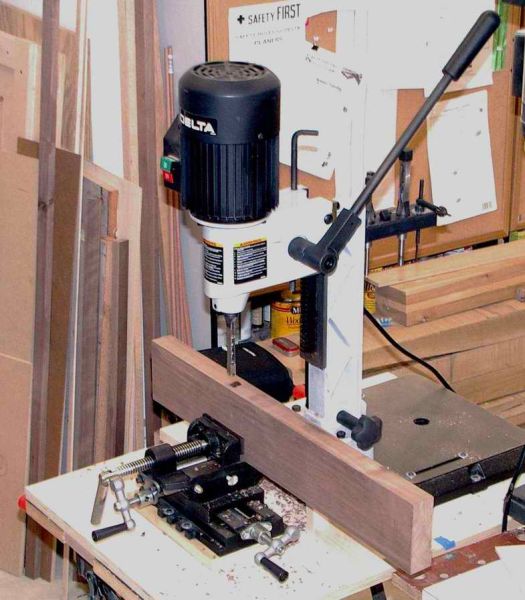Question
I need to make lots of through mortises in 1.25" thick quartered white oak. The mortise is .375 wide and 2.75" long. The ends need to be square. I have made some in the past using an inverted router and then finishing up the ends with hollow chisel, but the end result is not satisfactory. Anyone have good ideas? Would an oscillating chisel mortiser work well for this application?
Forum Responses
(Furniture Making Forum)
From contributor L:
If you have access to a square mortise chisel machine, then you just need to punch the mortise from both sides. This will eliminate the blowout from pushing the chisel through the bottom side. Using an oscillating machine will yield better results punching through, but you will still have blowout. Working from both sides will give you the best results with most tooling. The oscillating machine will give much quicker results than the square chisel, but it will be many times more expensive. If this is a one time ordeal, it isn't worth getting the new machine. If you do mortising as standard practice, this tool will be an excellent addition.
I mounted the vise in front of the mortising machine by first turning the head of the mortiser 180 degrees on the vertical post, which moved the base of the mortiser behind the head and out of the way. Essentially, that's mounting the head backward from the way Delta intended. The head hangs off the side of the base rather than centered over it. My mortiser also has a riser block, which gives me additional elevation of the head, and accommodates the height of the cross slide vise.
Using the cross slide vise lets me put the hollow chisel into the mortiser parallel with the vise jaws very easily. I simply lower the chisel between the jaws while tightened only very lightly, close the jaw faces against it carefully (mine are faced with hardwood rather than bare iron) and then tighten the chisel in the mortising machine well.
I can lock the front to back slide, which then positions the mortise between the sides of the work, typically centered, and know it is then going to remain exactly there, cut after cut. I then move the work in the vise left to right under the hollow chisel/drill in increments absolutely parallel to the face of the chisel. I can also flip the stock end for end, and mortise halfway through from one side and then halfway through from the other and have the two line up perfectly. Since you're able to move from side to side in controllable increments, you're essentially doing a step-and-repeat operation with a modestly priced mortising machine and a very inexpensive cross slide vise. The accuracy, if you're careful in the initial mounting of the mortiser and vise - getting everything square, plumb and parallel - is very high, as is the repeatability.
Since I build Arts & Crafts furniture with lots of mortise and tenon joinery, this setup has proven invaluable, and worth every dime... even though it wasn't a whole lot of dimes. This isn't an original idea, and there is another thread lurking here that describes this setup, including a small modification that the vise typically requires.
The Delta chisels (I have two sets... long story) that came with the mortiser are pretty much useless. They don't hold an edge well, and the faces all had to be ground smooth (now that was a real joy of a task with the water stones).
I'm using a set from Forest City that holds an edge very well, and are a marked improvement over the original Delta chisels. You can find those at Wood Tech Tooling. You'll need the conical sharpening stone (Japan Woodworker and Lee Valley both offer them) to keep them honed, but that's a fairly easy task with just a little care.
By the way, hardwood is easier on them than softwood (softwood crushes too easily, rather than having the fibers slice cleanly) in my experience, and I've chosen to stay well away from cutting mortises in softwood this way.
I think you'll see that the critical part of making this work is the initial positioning of the vise. If it is square/parallel/plumb with the mortising machine, it will be a joy to use. As I mentioned before, measuring and marking the mortises takes much more time than cutting them. And rotating the stock end for end (rather than rolling it) will let you accurately cut a mortise halfway in from each side and have it line up exactly. So if you've got a lot of 3/8" x 2 3/4" mortises to cut, this should enable you to do them productively and to like the results.

My sense of your posts is that a chain mortiser (which works exceptionally well in timber framing) won't create a through mortise in 1.25" white oak that is sharp, square and clean enough for your purposes (which I have assumed is fine furniture components). What I'm using produces clean, sharp and square mortises very well.
If you're talking about dozens per week, then what I've suggested and am using myself will work well. If you are talking hundreds, it becomes marginal at best. If you're talking thousands, then you need to find an importer for a Centauro BD/NV-Z or similar machine.